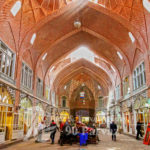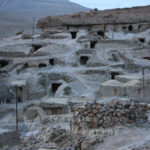Meidan Emam, Esfahan (#115)

The 17th century marked a period of prosperity for the city of Isfahan as Shah Abbas I established his capital there and built one of the biggest squares of all times in the city…
Persepolis (#114)

The footsteps of the empire that once encompassed a vast area from the Nile river in Egypt to Danube river in Europe and the Indus river in India, can be traced in the remains of Persepolis, in Fars Province of Iran…
TCHOGHA ZANBIL (#113)

The living memory of the ancient Elamite civilization is best represented in the remains of Tchogha Zanbil or the city of Untash, founded 1275-1240 BC…
TAKHT-E SOLEYMAN (#1077)

Characterized with a volcano and a Lake in its vicinity, the royal ensemble of Takht-e Soleyman has hosted the remains of palaces and royal structures dating back to the Sassanian Dynasty (3rd – 7th century AD). Thanks to its location, the area found a strong symbolic value for the Zoroastrian Sassanids, it became…
BAM AND ITS CULTURAL LANDSCAPE (#1208BIS)

In the heart of the desert in Kerman Province, the land rises in the form of mudbricks as a fortified settlement of at least a thousand years. Originating in the 6th to 4th centuries BC, the Citadel of Bam flourished through the ages as it was located on the crossroads of important trade routes…
PASARGADAE (#1106)

Deep in the heart of a vast piece of land called Persia, in Fars province, stands one of the last remains of the greatest empire that ruled over Iran. Cyrus the Great established Pasargadae in the 6th century BC, as the capital to an empir…
Soltaniyeh (#1188)

The centuries from 11th to 15th centuries marked the flourishing of the Islamic arts in Iran, one of the best manifestations of which is the Mausoleum of Oljaytu, in Soltaniyeh city of Zanjan Province. ..
BISOTUN (#1222)

Nestled in the heart of the sacred Mountains of Bisotun, in Kermanshah Province, lies an open museum with archeological remains from as early as the prehistoric times…
Armenian Monastic Ensembles (#1262)

Neighboring the Christian country of Armenia, in the north-west, has brought about an undeniably rich cultural dialogue and interrelation between the history of Iran and Armenia…
Shushtar Historical Hydraulic System (#1315)

Settling in a country with vast areas of arid or semi-arid lands has been one of the biggest challenges overcome by the Iranians throughout history…
Sheikh Safi-al din Khanegah and Shrine Ensemble in Ardabil (#1345)

Every step in Sheikh Safi-al din Khanegah and Shrine Ensemble, in Ardabil Province of Iran, is a step in the world of Sufi Mysticism…
Tabriz Historic Bazaar Complex (#1346)

As one of the important social hubs of the city of Tabriz throughout the centuries, the bazaar manifests the traditional commercial and cultural life of Iran…
The Persian Qanat (#1506)

Sustainable life in a country which is mostly covered by arid and semi-arid areas has been one of the primary goals of Iranians…
Gonbad-e Qabus (#1398)

The turn of the first millennium AD, in the Islamic world, marked the flourishing of mathematics and science, which were also reflected in the arts and architecture. Gonbad-e Qabus tower, the tomb of the Ziyarid ruler and writer of 11th century…
Masjed-e Jame of Isfahan (#1397)

Seeing the developments of architectural styles throughout centuries in only one structure is possible in the Masjed-e Jame or congregation mosque of Isfahan…
Golestan Palace (#1422)

The conventional and modern came together in the 19th century in the history of Iran. The Golestan Palace, in Tehran…
Shahr-i Sokhta (#1456)

The remains of an ancient city in the Sistan and Baluchistan province of Iran tells the story of the development of complex societies with the transformation of villages into cities, from 3200 BC until 1800 BC…
Cultural Landscape of Maymand (#1423rev)

For their lifestyle based on agro-pastoralism to thrive, the people of Maymand have developed a transhumance way of life, traveling between three settlements during the year…
Susa (#1455)

Located at the crossroads of the ancient Mesopotamian and Iranian civilizations, the city of Susa is the telltale heart of the history of Iran…
Lut Desert (#1505)

An area of 2,278,015 hectares of bare land covering a vast area in the south-east of Iran is occupied by the Lut Desert…
The Persian Qanat (#1506)

Sustainable life in a country which is mostly covered by arid and semi-arid areas has been one of the primary goals of Iranians…
Historic City of Yazd (#1544)

The city of earthen structures, domed houses, wind towers, old bazaars, and covered passageways is located near the central deserts of Iran…
Sassanid Archeological Landscape of Fars Region (#1568)

Tokens from deep history still stand in the southeast of Fars Province, bearing the treasures of architectural achievements from the early and late Sassanid period (224-658 AD)…


